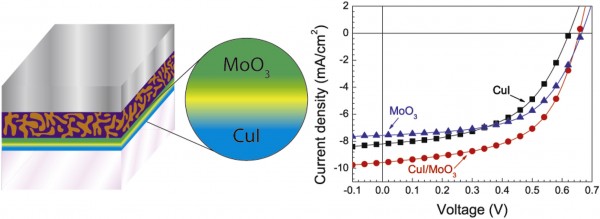Enhanced hole extraction by interaction between CuI and MoO3 in the hole transport layer of organic photovoltaic devices
- 저자
- Sangcheol Yoon, Hyebin Kim, Eul-Yong Shin, In-Gon Bae, Byoungchoo Park, Yong-Young Noh, Inchan Hwang
- 저널명
- Organic Electronics, 32, 200-207 (2016)
- 년도
- 2016
- Link
- http://dx.doi.org/10.1016/j.orgel.2016.02.036 278회 연결
[Abstract]
The selection of materials for use of a hole transport layer is crucial to improve the photovoltaic performances by means of efficient hole extraction. Herein, we investigate how the formation of a hybrid dual hole transport interlayer consisting of copper (I) iodide (CuI) and molybdenum oxide (MoO3) affects the efficiency of the device based on poly(3-hexylthiophene)(P3HT):[6,6]-phenyl-C61-butyric acid methyl ester (PCBM) blends. The rough surface of a CuI layer was observed when prepared on indium tin oxide (ITO) substrates, but became smooth by the thermal evaporation of MoO3 on the rough CuI surface, forming a dual layer. The devices incorporated with the layer show an enhancement in efficiency compared to the devices with the CuI or MoO3 alone layer, which is attributed to enhanced hole extraction. Our X-ray photoelectron spectroscopy (XPS) results show that Mo5+ defect states are increased by the interaction between MoO3 and CuI at the interface, giving rise to an increase in gap states, which we attribute to the improvement of hole extraction.
